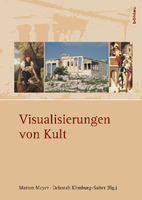Visualisierungen von Kult
Author(s)
Meyer, Marion
Klimburg-Salter, Deborah
Collection
Austrian Science Fund (FWF)Language
GermanAbstract
“Visualizations of cult“ deals with the strategies of visual representations of cult as well as with concretisations of its visualization, in the perspective of historical and cultural studies. Cult is understood in a broad sense, describing modes of collective veneration and auratization, in religious, quasi-religious or trivial-profane connections. Cult practice and experience and their manifestations are treated under five aspects: (1) objects: staging of cult, (2) subjects: experiences of cult, (3) cult of persons, (4) spaces of cult, (5) manifestations of cult practice. “Visualisierungen von Kult” behandelt die Strategien visueller Darstellung von Kult sowie Konkretisierungen seiner Visualisierung aus historisch-kulturwissenschaftlicher Perspektive. Kult ist weit gefasst und beschreibt Formen der kollektiven Verehrung und Auratisierung, in religiösen, quasi-religiösen oder trivial-profanen Zusammenhängen. Es werden Praktiken und Erfahrung von Kult und ihre Manifestationen in fünf Themenkomplexen untersucht: (1) Objekte: Inszenierungen von Kult, (2) Subjekte: Erfahrungen von Kult, (3) Personenkult, (4) Kulträume sowie (5) Manifestationen von Kultpraxis.
Keywords
Visual and cultural studies; visual communication; symbolic communication; media studies; self-representation; cult; cult of persons; votive practice; religion; sacred space; iconography; narration; Classical Archaeology; History of Art; History; History of Science; European Ethnology; Cultural Anthropology; Numismatics; Geology; film studies; television; politics; architecture; antiquity; middle ages; 20th century; Vienna; Pöggstall; Austria; Athens; Byzantium; Serbia; Kosovo; Ukraine; Portugal; Soma Morgenstern; Antonio Salazar; Slobodan Milošević; Theo Angelopoulos; Anna Stainer-Knittel; Geier-Wally; heroes; churches in Vienna; votive terracottas; Erechtheum; foundation sacrifices.; Visuelle Kulturgeschichte; visuelle Kommunikation; symbolische Kommunikation; mediale Inszenierung; Selbstdarstellung; Kult; Personenkult; Votivpraxis; Religion; sakrale Räume; Ikonographie; Narration; Klassische Archäologie; Kunstgeschichte; Geschichte; Wissenschaftsgeschichte; Europäische Ethnologie; K; António de Oliveira SalazarDOI
10.26530/oapen_477716OCN
952619334Publication date and place
2014Grantor
Imprint
BöhlauClassification
History


 Download
Download